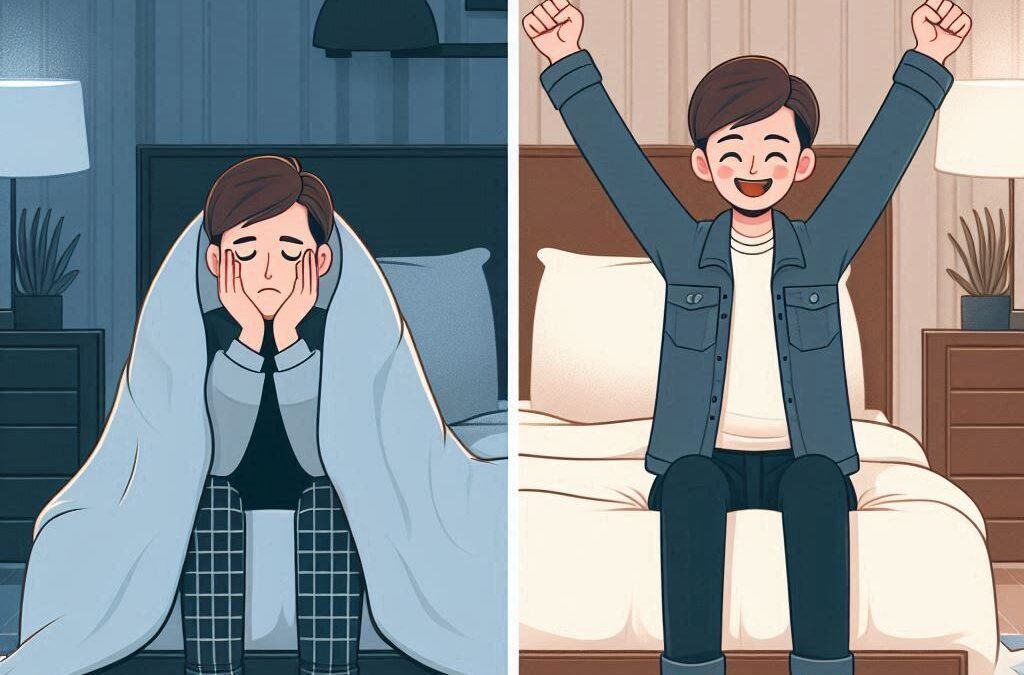Introduction
Insomnia, the persistent difficulty in falling or staying asleep, is a common issue that affects millions of people globally. It can lead to significant distress, impair daily functioning, and contribute to various health problems, including depression and anxiety. While medication is often prescribed to combat insomnia, it can come with side effects and may not address the underlying causes. Cognitive Behavioral Therapy for Insomnia (CBT-I) offers a natural, effective, and long-term solution. In this blog post, we’ll explore what CBT-I is, how it works, and the steps involved in the therapy process.
What is Cognitive Behavioral Therapy for Insomnia (CBT-I)?
CBT-I is a structured, evidence-based therapy that aims to improve sleep by changing sleep habits and misconceptions about sleep and insomnia. Unlike medication, which often provides short-term relief, CBT-I focuses on addressing the underlying causes of insomnia, leading to long-term improvements in sleep quality.
Several studies have demonstrated the effectiveness of CBT-I. A landmark study published in The Lancet Psychiatry found that CBT-I significantly improved sleep quality and duration, with effects lasting long after the treatment ended. Another study in the Journal of the American Medical Association (JAMA) showed that CBT-I was more effective than sleep medication in the long run.
How Does CBT-I Work?
CBT-I combines cognitive therapy with behavioral interventions. The cognitive component helps individuals identify and change unhelpful thoughts and beliefs about sleep, while the behavioral component focuses on developing healthy sleep habits and routines.
The CBT-I Procedure
1. Assessment and Sleep Diary
The first step in CBT-I is a comprehensive assessment conducted by a trained therapist. This may include questionnaires and interviews to understand your sleep patterns, behaviors, and thoughts related to sleep. You may also be asked to keep a sleep diary for a couple of weeks to track your sleep patterns, wake times, and any factors that may affect your sleep.
2. Sleep Education
Understanding the basics of sleep is crucial for effective treatment. Your therapist will educate you about sleep, including the sleep cycle, the importance of sleep hygiene, and factors that can affect sleep. This knowledge helps demystify sleep and reduces anxiety related to insomnia.
3. Cognitive Restructuring
The cognitive component of CBT-I involves identifying and challenging negative thoughts and beliefs about sleep. Common unhelpful thoughts include “I will never fall asleep” or “I can’t function without eight hours of sleep.” Your therapist will work with you to replace these thoughts with more realistic and positive ones, such as “Even if I don’t sleep well tonight, I can still function tomorrow.”
4. Stimulus Control Therapy
Stimulus control therapy aims to associate the bed and bedroom with sleep and relaxation, rather than wakefulness and frustration. Key strategies include:
– Going to bed only when sleepy.
– Using the bed only for sleep and intimacy, avoiding activities like watching TV or working in bed.
– Getting out of bed if unable to sleep within 20 minutes, and returning only when sleepy.
– Waking up at the same time every day, regardless of the amount of sleep.
5. Sleep Restriction Therapy
Sleep restriction therapy involves limiting the amount of time spent in bed to match the actual amount of sleep you’re getting. This initially leads to mild sleep deprivation, which increases sleep drive and improves sleep efficiency. Gradually, as your sleep improves, the time spent in bed is increased.
For example, if you typically spend eight hours in bed but only sleep for five, your therapist might initially restrict your time in bed to five hours. As your sleep becomes more consolidated, the time in bed is gradually increased.
6. Relaxation Techniques
Relaxation techniques can help reduce the physical tension and mental anxiety that often accompany insomnia. Common techniques include:
– Progressive Muscle Relaxation (PMR): Involves tensing and then relaxing different muscle groups in the body.
– Deep Breathing: Focused, slow breathing can promote relaxation.
– Mindfulness Meditation: Involves paying attention to the present moment without judgment, which can reduce stress and promote sleep.
7. Sleep Hygiene Education
Sleep hygiene involves creating an optimal environment and routine for sleep. Your therapist will provide tips on:
– Keeping a consistent sleep schedule.
– Creating a relaxing bedtime routine.
– Making the sleep environment comfortable (cool, dark, and quiet).
– Avoiding caffeine, nicotine, and heavy meals close to bedtime.
– Limiting exposure to screens and blue light before bed.
The Benefits of CBT-I
CBT-I offers several benefits compared to other treatments for insomnia:
– Long-lasting results: Unlike medication, the effects of CBT-I persist long after the treatment has ended.
– No side effects: CBT-I is a natural treatment with no adverse side effects.
– Improves overall health: Better sleep can lead to improvements in mood, cognitive function, and overall quality of life.
– Addresses root causes: CBT-I focuses on the underlying causes of insomnia, rather than just the symptoms.
Conclusion
Cognitive Behavioral Therapy for Insomnia (CBT-I) is a powerful, evidence-based treatment that can help you overcome insomnia and achieve restful, rejuvenating sleep. By addressing the underlying causes of sleep difficulties and developing healthy sleep habits, CBT-I offers a natural and long-lasting solution. If you’re struggling with insomnia, consider seeking out a trained CBT-I therapist to guide you through the process and help you unlock the restful nights you deserve.
Remember, good sleep is not a luxury—it’s a necessity for a healthy, fulfilling life.

